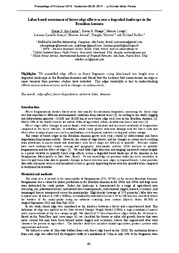Lidar-based assessment of forest edge effects across a degraded landscape in the Brazilian Amazon.
Lidar-based assessment of forest edge effects across a degraded landscape in the Brazilian Amazon.
Autoria: SANTOS, M. N. dos; PINAGÉ, E. R.; LONGO, M.; ARAUJO, L. S. de; ADAMI, M.; MORTON, D.; KELLER, M.
Resumo: Forest fragmentation divides forest areas into smaller discontinuous fragments, increasing the forest edge area that experiences different environmental conditions from interior areas [1]. According to one study, logging and deforestation generate ~32,000 and 38,000 km of new forest edge each year in the Brazilian Amazon [2]. Nearly 20% of the world?s forests are within 100m of agriculture, urban, or other non-forest land uses [3]. Forest edges suffer changes in microclimate, with reduced moisture and increased variability of temperature compared to the forest interiors. In addition, winds cause greater structural damage near the forest ends and affect other ecological processes such as pollination, seed dispersal, nutrient cycling and carbon storage. The extent of forest edges in the Brazilian Amazon grows each year, caused by deforestation and forest degradation from human activity. However, the extent of edge forests, and the changes in carbon stock resulting from alterations in microclimate and disturbance near forest edges are difficult to quantify. Previous studies have used multispectral remote sensing and geographic information systems (GIS) analysis to quantify fragmentation and the effect of edges [2]. We used lidar (light detection and ranging) measured canopy heights as a proxy variable to quantify forest edge effects across a degraded forest landscape of the Amazon in the Paragominas Municipality in Para State, Brazil. To our knowledge no previous study has used variability in forest height from lidar data to quantify changes in forest structure near edges in tropical forests. Lidar provides data with sub-meter vertical and horizontal accuracy, greatly improving forest structure quantification compared to traditional field studies.
Ano de publicação: 2015
Tipo de publicação: Artigo em anais e proceedings
Unidade: Embrapa Territorial
Palavras-chave: Airborne lidar, Amazon, Edge effect, Forest degradation
Observações
1 - Por padrão são exibidas publicações dos últimos 20 anos. Para encontrar publicações mais antigas, configure o filtro ano de publicação, colocando o ano a partir do qual você deseja encontrar publicações. O filtro está na coluna da esquerda na busca acima.
2 - Para ler algumas publicações da Embrapa (apenas as que estão em formato ePub), é necessário ter, no celular ou computador, um desses softwares gratuitos. Sistemas Android: Google Play Livros; IOS: iBooks; Windows e Linux: software Calibre.
Acesse outras publicações
Acesse a Base de Dados da Pesquisa Agropecuária (BDPA) para consultar o acervo completo das bibliotecas da Embrapa.

